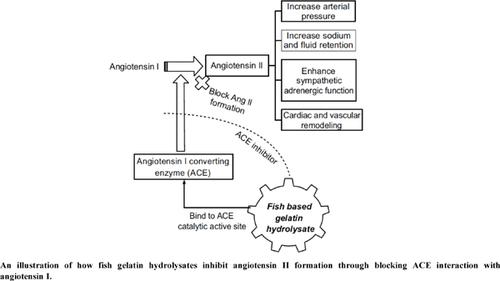Mini-Reviews in Organic Chemistry ( IF 1.9 ) Pub Date : 2021-08-31 , DOI: 10.2174/1570193x17666200831180801 Yoni Atma 1

|
Gelatin produced from fish processing by-product is the most potential alternative source of gelatin. They have biological activities, particularly antioxidant, antihypertensive, and reduce type 2 diabetic risk. This paper reviews the mechanisms of fish gelatin hydrolysates for those human diseases being discussed in recent studies. Based on the review, mostly, skin and bone are used as sources of fish-based gelatin in which about thirty percent comes from the weight of total fish. Some species have been analysed based on their bioactivities, including Tuna, Nile tilapia, Amur sturgeon, Pangasius catfish, Cod, Blacktip shark, Salmon, Halibut, and Tilapia fish. In short, the antioxidant mechanism of this fish-based gelatin is by scavenging and neutralizing the radicals. The antihypertensive mechanism is by inhibition of Angiotensin-Converting Enzyme (ACE) activity. Whilst the mechanism to reduce type 2 diabetes is by inhibiting dipeptidyl peptidase IV (DPP-IV) action.
中文翻译:

鱼明胶水解物具有抗氧化、抗高血压和抗糖尿病作用:可能的机制
从鱼类加工副产品中生产的明胶是最有潜力的明胶替代来源。它们具有生物活性,特别是抗氧化、抗高血压和降低 2 型糖尿病风险。本文回顾了鱼明胶水解物对最近研究中讨论的那些人类疾病的作用机制。根据审查,大多数情况下,皮肤和骨头被用作鱼基明胶的来源,其中约 30% 来自总鱼的重量。一些物种已根据其生物活性进行了分析,包括金枪鱼、尼罗罗非鱼、阿穆尔鲟、鲶鱼、鳕鱼、黑鳍鲨、鲑鱼、大比目鱼和罗非鱼。简而言之,这种鱼基明胶的抗氧化机制是通过清除和中和自由基。抗高血压机制是通过抑制血管紧张素转换酶 (ACE) 的活性。而减少 2 型糖尿病的机制是通过抑制二肽基肽酶 IV (DPP-IV) 的作用。






























 京公网安备 11010802027423号
京公网安备 11010802027423号